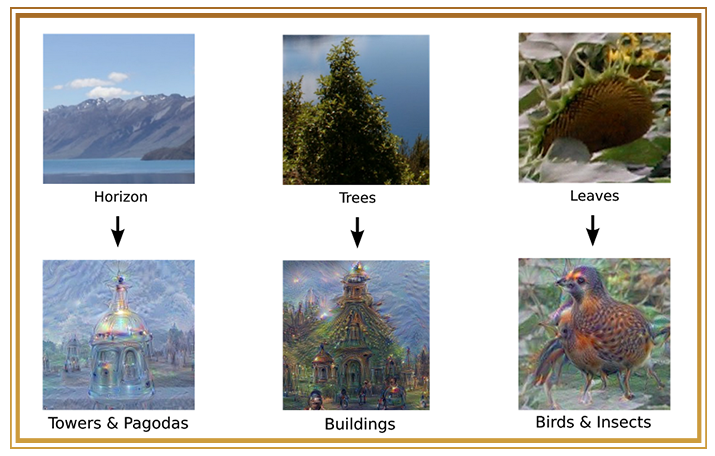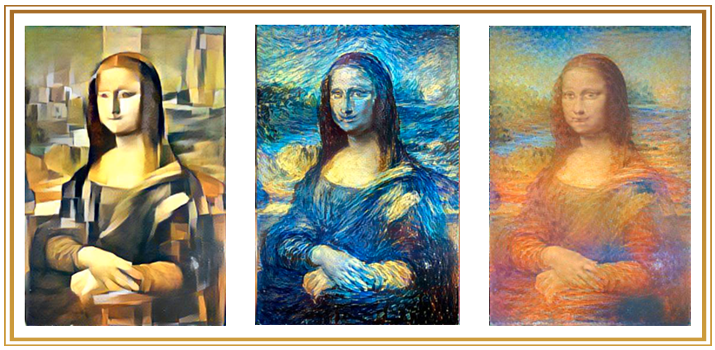What Is Neural Network Art?

Photo Credit: Image by Google Inc. under a Creative Commons Attribution 4.0 International License.
In recent years, advances in artificial intelligence (AI) have given rise to a new phenomenon: neural networks. By designing AI to mimic the human brain at a basic level, computer scientists are able to create machines capable of “deep learning;” that is, machines that can learn basic concepts and apply those concepts in situations other than the ones in which they learned them.
While neural networks are used for a variety of purposes, one of the more fascinating applications is neural network art: visual art, music and other forms of creative expression designed by algorithms.
Neural Network Art
Neural networks make use of “deep learning,” a concept that uses our limited understanding of how the human brain works to create networks of algorithms that can “learn” from supplied data. These networks of algorithms, called neural networks, are arranged in a way that imitates the way neurons in the brain connect to each other. Layers of algorithms are able to process increasingly complex data, and their connections to each other further increase that capability. This method of creating AI generates machines that can learn from data inputs and even make guesses based on that data.
Scientific American describes how a neural network can learn to recognize faces:
“To recognize a face, the network sets about the task of analyzing the individual pixels of an image presented to it at the input layer. Then, at the next layer, it chooses geometric shapes distinctive to a particular face. Moving up the hierarchy, a middle layer detects eyes, a mouth and other features before a composite full-face image is discerned at a higher layer. At the output layer, the network makes a ‘guess’ about whether the face is that of Joe or rather that of Chris or Lee.”
But a neural network’s ability extends beyond simply processing inputs and making guesses about them. Neural networks can create outputs based on the data they’re given, a capability that has recently been used to create audio and visual art.
The Emergence of AI Art
Neural networks are being used by artists to enhance or supplement their artistic efforts or to create entirely new pieces of art. Digital art has been around long enough to be acknowledged as its own medium, but Adobe’s Wetbrush technology is blurring the line between digital art and painting. In the past, creating an effect in a digital medium to mimic the look of paint has proved difficult, but Wetbrush uses algorithms and a physics simulation system to create digital brush strokes that appear to have the texture and color of oil paint. Pictures created using Wetbrush can even be printed in 3-D to bring out the natural lighting effects of an oil painting.
Bhautik Joshi, a researcher at Adobe, even applied neural network art to an existing film. Joshi used neural networks to create an effect similar to Pablo Picasso’s cubist style in Stanley Kubrick’s 2001: A Space Odyssey, creating a multi-colored, kaleidoscopic reimagining of the science fiction classic.
Neural networks can be applied to music, too. Flow Machines, a research project coordinated by Sony, was created to “research and develop Artificial Intelligence systems able to generate music autonomously or in collaboration with human artists.” By feeding Flow Machines data, such as compositions by artists ranging from Bach to the Beatles, the neural network is able to create music, including a pop song called “Daddy’s Car,” a collaboration with French songwriter Benoît Carré.
Computer scientists are even experimenting with using neural networks to make video games. Angelina, developed by British researcher Michael Cook, creates video games by scanning online newspaper articles for themes and incorporates those themes with visuals taken from the web. While these games lack the complex narrative structures of modern video games, Angelina is able to create games with goals and activities for players to complete.

Photo Credit: Image by Google Inc. under a Creative Commons Attribution 4.0 International License.
Google’s Deep Dream
Perhaps the most famous example of neural network art is that produced by Google’s Deep Dream Generator. A complex network working with countless pieces of visual data, Deep Dream is an open source neural network art project that any internet user can interact with, feed images to and receive those images back, reinterpreted by Deep Dream.
One of the things that research with Deep Dream illustrates is that the processes that happen at different layers of a neural network are still largely mysterious to computer scientists. While researchers know that each subsequent layer processes increasingly complex and sophisticated types of information, the data that is specifically isolated by each layer is unclear. Google researchers work with Deep Dream, producing results using specific layers of the network in order to learn more about how Deep Dream interprets and produces images.
Deep Dream was — and continues to be — trained with many visual examples of various objects, like animals, fruit, trees and people. Deep Dream is capable of creating new art based on images it’s given, but that art often adheres to themes based on preconceptions Deep Dream develops over time. “For example, horizon lines tend to get filled with towers and pagodas,” according to Google. “Rocks and trees turn into buildings. Birds and insects appear in images of leaves.”
Many of Deep Dream’s pictures are created using a technique called “inceptionism,” where multiple different images are combined within the program to create something of an amalgam of the source images. But Deep Dream doesn’t need images of specific objects to create art; it is capable of producing pictures based on random noise images that do not contain any discernable shapes.

Photo Credit: Mona Lisa recreated in the styles of Picasso, Van Gogh, and Monet by artist Gene Kogan using style transfer.
And, the more images it obtains, the more sophisticated — and unique — its process becomes. From collaborations with artist Gene Kogan to a two-day exhibit that raised around $84,000, Deep Dream’s art has become increasingly prominent.
Other Neural Network Art
Many computer scientists are exploring what can be done artistically with neural networks in an effort to better understand how they work, how they process image data and how they make decisions. From projects experimenting with inceptionism to work done by organizations like the Visual Geometry Group, neural network art research is a growing field.
As the field grows and researchers learn more about how neural networks work, the need to share information and experiment collaboratively becomes more important, in order to better understand neural network art.
Pursuing a Career in Computer Science
Neural network art wouldn’t be possible without skilled computer scientists developing the code that allows deep learning to function. With an online computer science degree from Concordia University Texas, you can apply your computer science skills to research fields like neural networks. Learn in a flexible environment on a schedule that fits into your life.
